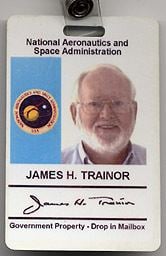Name James Trainor | Role Physicist | |
 | ||
Died 2003, Los Alamitos, California, United States | ||
James H. Trainor (August 22, 1935 – October 4, 2003) was an American physicist.
Biography
He was born in Lancaster, New Hampshire, the son of Peter D. and Bernice E. Trainor. He graduated in 1953 from Lancaster Academy, where he was the class valedictorian. He attended the University of New Hampshire in Durham, where he received a bachelor of science degree in physics in 1958 and a master's degree in physics in 1959. He earned his Ph.D. from UNH in 1964 and made history by being one of the first two simultaneous graduates of that university to receive a doctorate in physics. From 1962 to 1964, he was a U.S. Air Force research fellow. He later lived in Greenbelt, Maryland, Silver Spring, Maryland, and Chincoteague, Virginia before moving to Seal Beach, California.
Immediately after the Starfish Prime high-altitude nuclear test in 1962, the U.S. military realized it had no ability to collect accurate data on the intense and persistent radiation belts created by the blast. This would lead Edward Teller to appropriate a satellite instrument designed and built by Trainor, then a graduate student in the physics department at the University of New Hampshire. Trainor had no choice but to provide his instrument, originally designed to study cosmic ray neutron albedo, to the U.S. government along with all its data bus specifications and complete documentation. Trainor was not told why his graduate work was being appropriated. The instrument was immediately flown to California where engineers were to graft it onto other equipment before launching it into orbit. However, the engineers apparently became confused over some technical detail and felt they needed to make better contact with Trainor. After the data from the satellite returned to earth, and about a week after the detonation, Trainor was invited to a scientific meeting where the data collected from his instrument were discussed in a packed room at the Lawrence Livermore Laboratory.
Dr. Trainor joined the National Aeronautics and Space Administration in 1964 as a research physicist. He served in a number of significant positions that included those of Instrumentation Branch head, associate chief of the Laboratory for High Energy Astrophysics, and, then in 1987, director of the Space and Earth Sciences Directorate, the latter of which contained more than one-half of all NASA scientists. He was a NASA project scientist for many space flight projects and balloon and sounding rocket programs. He was personally responsible for 15 successful experiments launched on NASA and U.S. Air Force missions, and was the author or co-author of more than 60 scientific and engineering publications. He was also responsible for the oversight of hundreds of flight instruments.
Before he retired from NASA on September 3, 1994, after 30 years of service, Dr. Trainor had been associate director and chief scientist of NASA's Goddard Space Flight Center in Greenbelt, Maryland for five years and the principal assistant to the center's director for the oversight of science, engineering, computing and technology. Goddard is responsible for managing, developing, launching and operating about two-thirds of all NASA satellites. Since his retirement, Dr. Trainor had served in a continuing role as a consultant and chair of the Review Board for the ACE spacecraft instruments and IMAGE instruments and spacecraft. In recent years, he had made special contributions throughout NASA as an expert in sensor systems, flight electronic systems and nuclear radiation effects.
Dr. Trainor received many awards, including the NASA Medal for Exceptional Scientific Achievement in 1974, the NASA Medal for Exceptional Service in 1987, the Meritorious Rank Presidential Award (Senior Executive Service) in 1987 (selected by President Ronald Reagan), the Distinguished Executive Presidential Award in 1991 (awarded at the White House by President George H. W. Bush) and the NASA Medal for Distinguished Service in 1994. He was a member of many scientific and aeronautical organizations, including the Institute of Electrical and Electronics Engineers, which awarded him a Lifetime Fellowship in 1984. He was also a member of Phi Kappa Phi. In 1979, he was awarded a NASA Research and Study Fellowship and was a Visiting Associate at the California Institute of Technology in Pasadena.
Dr. Trainor died in Los Alamitos, California on October 4, 2003. He is survived by his wife of 41 years, Mary (Mirijanian) Trainor of Seal Beach, California; a son, Douglas J. Trainor of Phoenixville, Pennsylvania; a daughter, Dr. Jennifer L. Trainor of Hinsdale, Illinois; two grandchildren, Eli Trainor Seo and Gabriella Trainor Seo, both also of Hinsdale; a brother, Paul D. Trainor of Martinez, Georgia; a sister, Catherine M. Huffman of Peoria, Arizona; a son-in-law, Dr. Robert M. Seo of Hinsdale; a daughter-in-law, Dr. Xuan Hong of Phoenixville; two aunts, Maida Fortin of Lancaster, New Hampshire, and Geneva Daisy of Holyoke, Massachusetts; and several cousins in New Hampshire and Massachusetts.
A special memorial service for Dr. Trainor was held Wednesday, November 5, 2003 from 3 to 5 p.m., at the Goddard Space Flight Center in Greenbelt, Maryland.
